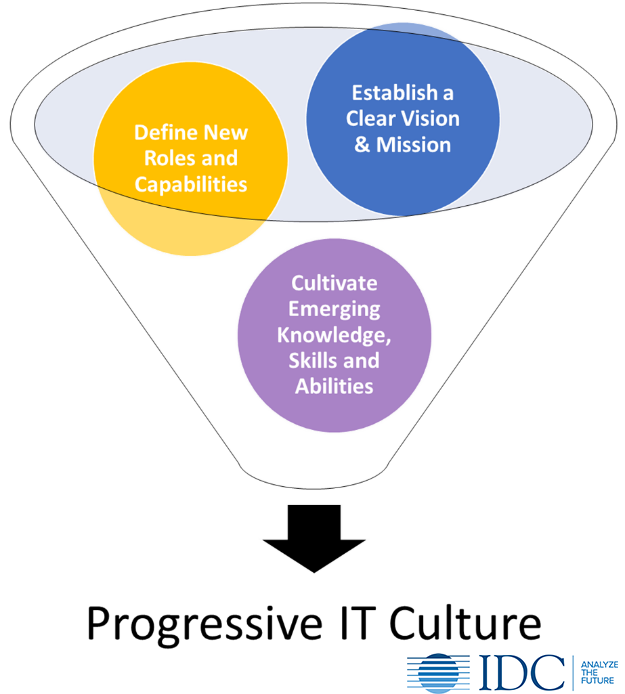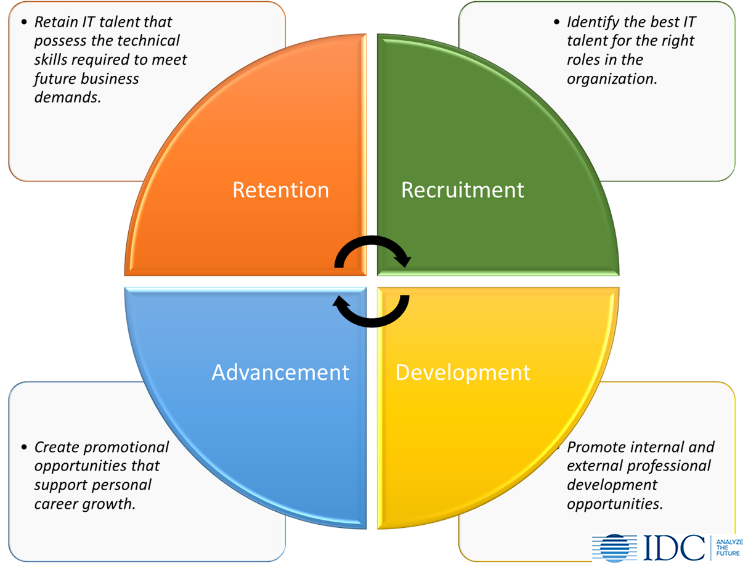IT leaders must act now to thoughtfully create a workplace culture that promotes key competencies such as learning agility, collaboration, adaptability, and inclusive practices to meet future business demands, particularly given the ever-evolving nature of the future of work.
Why Should IT Leaders Take Action Now?
Here’s a brief summary of the several talent headwinds that IT leaders can expect to encounter over the next decade in the global marketplace:
- According to a recent report by Korn Ferry, “A major crisis is coming, a seismic shock that will impact organizations and economies around the world. Global labor shortages of 85.2 million skilled workers are projected by 2030, resulting in lost revenue opportunities of $8.452 trillion — the combined GDP of Germany and Japan” (available at www.kornferry.com/challenges/future-of-work);
- According to the IDC FutureScape: Worldwide CIO Agenda 2020 Predictions, by 2023, driven by the mandate to deliver engaging, agile, continuous learning-fueled workspaces, 60% of CIOs will implement formal employee experience programs.”; and
- According to the IDC FutureScape: Latest Worldwide Future of Work Predictions (2019) “By 2021, the contribution by “digital coworkers” will increase by 35% as more tasks are automated and augmented by technology, including AI, robotics, AR/VR, and intelligent process automation.”
Additionally, the accelerated adoption of digital transformation resulting from the global business impact of COVID-19 this year will more than likely fast-track the increased utilization of “digital coworkers” to automate and/or augment routine work tasks across all industries moving forward.
How Can IT Leaders Effectively Address These Various Challenges?
IT Leaders must first take appropriate actions to build a Progressive IT Culture that will continuously attract, develop, and retain IT talent with diverse technical skill sets and leadership capabilities (refer to the illustrative model below).

Establish a Clear Vision and Mission: A Vision Statement succinctly outlines “who” the IT organization aspires to be in the future relative to the company’s overall business strategy and doing so creates a clear sense of purpose for the IT organization. It also provides a strategic “North Star” to the IT organization during periods of uncertainty or unplanned shifts in the marketplace that directly impact the business strategy. Next, the IT leadership team can develop a compelling Mission Statement describing “what” the IT organization aims to accomplish in the near future in pursuit of the Vision Statement, including identifying key performance indicators to regularly track progress against core strategic objectives.
Establishing a persuasive Vision Statement and an impactful Mission Statement is key to building a transformative and sustainable workforce development strategy. Each of these strategic declarations work in concert with one another to clearly communicate how the IT organization expects to deliver value to both internal and external constituents, which is critical to successfully attracting, developing, and retaining IT talent.
Define New Roles and Capabilities: According SHRM, “HR professionals need to know if new skills are becoming critical for existing roles, how roles are changing, and what entirely new roles are emerging. With a combination of current, historical, and predictive data, employers can see which skills are in high demand and how that demand may shift in the future” (see “Improve Workforce Planning by Applying Labor Market Context,” SHRM, January 2017). Therefore, IT Leaders should actively engage their respective HR business partners to evaluate evolving labor market conditions and identify new job skills and capabilities required to meet future business demands. Then, their HR business partner can create a new skill profile, including:
- General description of the new position (i.e., narrative);
- Key roles/responsibilities;
- New technical skills and leadership capabilities required; and
- Expected value this role will deliver to the organization.
Next, the Talent Acquisition Team can help develop a targeted recruiting strategy for new roles, which should be strategically aligned with the IT organization’s vision and mission.
Cultivate Emerging Knowledge, Skills, and Abilities: Now more than ever, IT Leaders must take a more proactive and holistic approach with respect to talent management that will allow them to strategically develop their own IT talent with the right technical skills (i.e., grow strategy) instead of depending on successfully acquiring technical talent (i.e., buy strategy) moving forward. By implementing a comprehensive and dynamic human capital management strategy, IT Leaders can continuously identify critical technical and leadership capabilities required to meet core business requirements and also create the necessary “stickiness factor” at each stage of the employee life cycle to retain IT talent with the emergent knowledge, skills and abilities for the future (refer to the illustrative model below).

What Meaningful Steps Can IT Leaders Take Now?
There are several initial steps that IT Leaders can take now to begin building a Progressive IT Culture, including:
- Develop a clear vision and mission for the IT organization, including critical technical and leadership competencies, and share it with all key stakeholders (i.e., IT Staff; Human Resources; Marketing; and other key business partners);
- Partner with their respective HR leadership to assess the organization’s human capital management system;
- Identify existing talent strategies at each stage of the employee life cycle that help drive and enable the overall vision of the IT organization today;
- Implement new human capital strategies at each stage of the employee life cycle that will significantly contribute to cultivating a progressive IT culture in the future; and
- Identify organizational metrics to consistently track progress toward core strategic objectives.
In closing, this dynamic workforce development strategy is a marathon and not a sprint. Therefore, it is imperative that IT Leaders find a variety of ways to consistently model the same workplace behaviors and core competencies that they are committed to developing across the entire IT organization. Most importantly, IT Leaders must always remember to be resilient, celebrate their successes, learn from their mistakes, and enjoy the journey!
Learn more about how to successfully attract, develop, and retain the next generation of IT talent.




